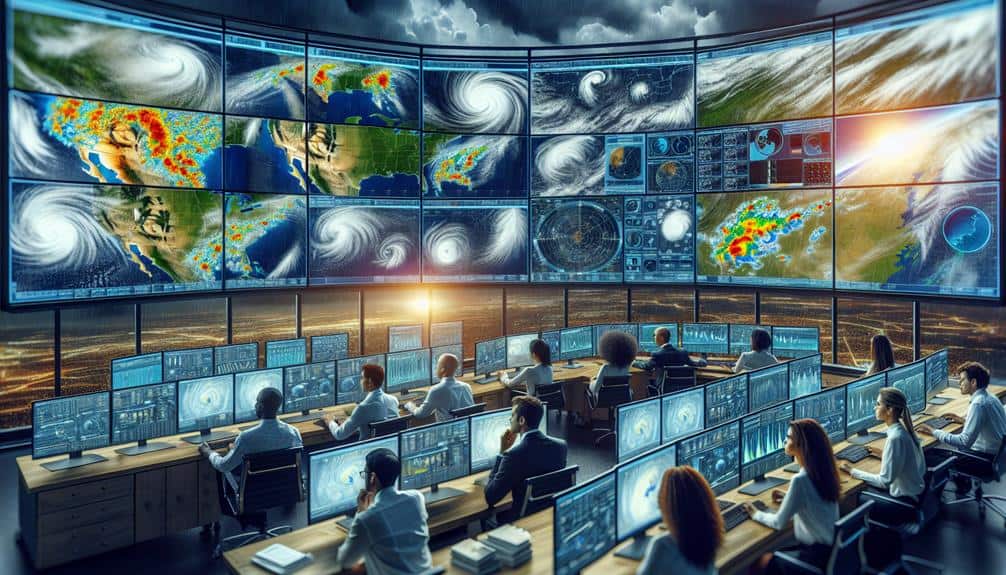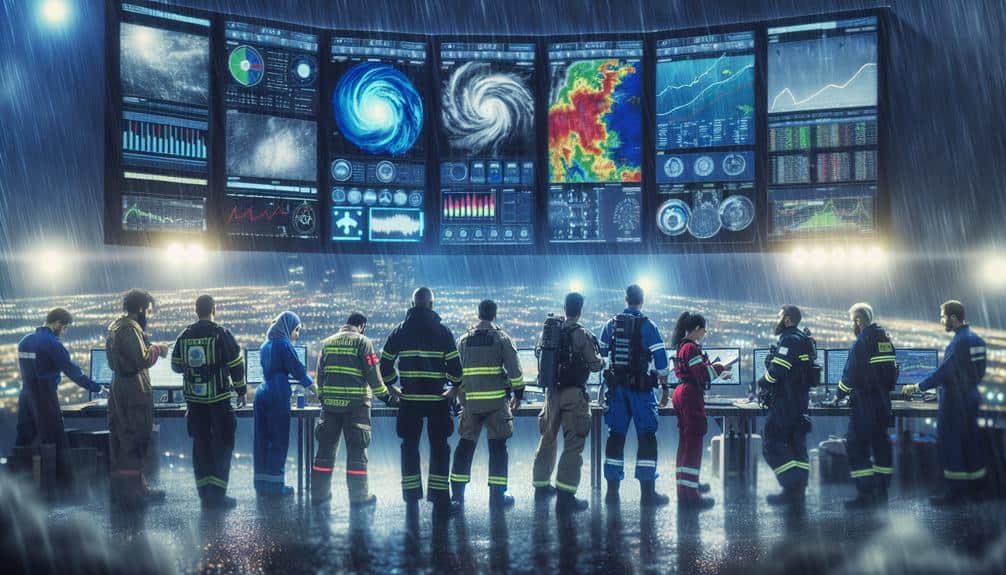We rely on real-time storm forecasting tools to enhance safety and improve our emergency response tactics. By utilizing advanced predictive models and machine learning algorithms, we increase the accuracy of our forecasts. Real-time data from sensors and radar systems empower us with precise, up-to-date predictions, enabling timely resource allocation and public awareness initiatives. These tools support critical infrastructure protection, efficient budget allocation, and strategic decision-making. They also provide invaluable datasets for ongoing weather research, driving innovation in prediction technologies. For a deeper understanding of their multifaceted benefits, let's explore further advancements and applications.
Key Points
- Real-time forecasting enables timely dissemination of information and enhances emergency preparedness.
- Advanced predictive models and data integration improve the accuracy of storm forecasts.
- Continuous updates provide current data for proactive decision-making and public safety.
- Accurate predictions support efficient resource deployment and emergency response coordination.
Enhancing Safety Measures
By leveraging real-time storm forecasting tools, we can greatly enhance our safety measures and preparedness strategies. These tools allow us to monitor weather patterns with precision, enabling timely dissemination of vital information. Real-time data equips us to implement emergency preparedness plans effectively, ensuring that communities have the knowledge and resources needed to respond swiftly to impending storms.
Through advanced forecasting, we can issue early warnings, giving individuals and organizations the lead time required to secure properties and evacuate if necessary. This proactive approach not only mitigates damage but also saves lives. Public awareness campaigns based on accurate, real-time data empower people to make informed decisions about their safety.
Furthermore, these tools facilitate better coordination among emergency services. When we share real-time data with first responders, it enhances their ability to deploy resources where they're most needed. This collaborative effort increases overall community resilience to storms.
In essence, real-time storm forecasting tools are essential for reinforcing our emergency preparedness and boosting public awareness. By integrating these technologies into our safety protocols, we create a more responsive and informed society, ready to face storm-related challenges head-on.
Improving Accuracy
To enhance the accuracy of storm forecasts, we must focus on advanced predictive models and data integration techniques.
By leveraging machine learning algorithms and assimilating diverse data sources, we can enhance predictive precision.
These improvements will allow us to provide more reliable and timely information to mitigate storm impacts.
Advanced Predictive Models
Leveraging machine learning algorithms, we can significantly enhance the accuracy of storm forecasting models. By integrating predictive analytics with advanced weather monitoring systems, we're able to process vast amounts of data in real time. This enables us to identify patterns and trends that traditional methods might miss. Machine learning models learn from historical weather data and adapt as new data becomes available, continually refining their accuracy.
Predictive analytics allows us to analyze complex meteorological variables such as temperature, humidity, wind speed, and atmospheric pressure. These variables are essential for predicting storm behavior. By employing sophisticated algorithms, we can simulate different storm scenarios and assess their potential impacts with a high degree of precision. This is particularly important for regions prone to severe weather, where timely and accurate forecasts can save lives and reduce property damage.
Moreover, machine learning models facilitate rapid decision-making. We're not just relying on static models; instead, we're using dynamic systems that evolve with each new piece of data. This adaptability enhances our ability to provide more accurate and timely storm forecasts.
Ultimately, this technological advancement empowers us with the freedom to make informed decisions, minimizing the adverse effects of storms on our communities.
Data Integration Techniques
Integrating diverse data sources like satellite imagery, radar readings, and ground-based sensors, we can greatly enhance the precision of storm forecasting models. By combining these varied datasets, we create a more all-encompassing view of atmospheric conditions. Each data source offers unique insights—satellites provide extensive coverage, radars deliver real-time precipitation data, and ground sensors offer localized measurements.
To process this wealth of information, we turn to machine learning algorithms. These algorithms excel at identifying patterns and correlations that might elude traditional statistical methods. Machine learning not only increases the accuracy of predictions but also adapts to new data, continually refining the models.
Data visualization plays an important role in this integration process. Effective data visualization techniques enable us to interpret complex datasets quickly, highlighting critical trends and anomalies. Visual tools transform raw data into intuitive, actionable insights, making it easier for meteorologists to make informed decisions.
Timely Data Access

Accessing timely data is crucial for the accuracy and reliability of real-time storm forecasting tools. When we acquire data instantly, we enable a quick response to imminent threats, providing critical information to those in affected areas. This immediacy guarantees that our forecasts aren't only precise but also actionable, allowing individuals and communities to make informed decisions swiftly.
We depend on a network of advanced sensors, satellites, and radar systems to gather real-time data on atmospheric conditions. These tools provide us with high-resolution, up-to-the-minute information on wind speeds, precipitation levels, and storm trajectories. By integrating this data seamlessly into our forecasting models, we can generate precise and reliable predictions that empower those who need it most.
Timely data access also means that we can continuously update our forecasts as new information becomes available. This iterative process ensures that our predictions remain relevant and accurate, even as conditions change rapidly.
For those who value freedom, the ability to act on the most current data is essential. It allows us to take control of our safety and make proactive decisions, rather than reacting to outdated or incomplete information.
Facilitating Research
Facilitating research, real-time storm forecasting tools provide invaluable datasets that enable scientists to analyze weather patterns and improve predictive models. By leveraging these tools, we can enhance our understanding of atmospheric dynamics, which is critical for advancing meteorological science.
The continuous flow of real-time data fosters research collaboration across institutions, allowing us to collectively push the boundaries of what's achievable.
Here's how real-time storm forecasting tools elevate our research:
- Data Collection: They gather high-resolution data from multiple sources, including satellites, radars, and sensors, giving us a complete view of storm systems.
- Predictive Modeling: Access to real-time data allows us to fine-tune predictive models, making them more accurate and reliable over time.
- Interdisciplinary Collaboration: These tools enable seamless data sharing among meteorologists, climatologists, and other scientists, fostering a collaborative research environment.
- Technology Advancements: Continuous improvements in forecasting technology drive innovation, providing us with new methodologies and tools to address complex weather phenomena.
Supporting Emergency Response

Real-time storm forecasting tools not only advance our research but also play a crucial role in supporting emergency response teams by providing timely and accurate data. These tools enable us to predict storm paths, intensities, and potential impacts, which are essential for emergency coordination. By having precise forecasts, we can deploy resources efficiently, prioritize areas at highest risk, and implement precautionary measures well in advance.
Accurate storm forecasts enhance public awareness, allowing individuals to take informed actions to protect themselves and their properties. When communities receive reliable warnings, they can evacuate if necessary, secure their homes, and gather essential supplies. This proactive approach minimizes casualties and damage, fostering a sense of security and autonomy among the public.
Moreover, real-time data feeds into communication systems that keep everyone—from government agencies to local communities—on the same page. This synchronization is crucial for seamless emergency coordination, ensuring that efforts are neither duplicated nor wasted.
Optimizing Resource Allocation
By utilizing real-time storm forecasting tools, we can optimize resource allocation to safeguard that emergency response efforts are both effective and efficient. These tools offer precise, timely data that assist in making informed decisions, thereby improving our cost efficiency and infrastructure planning.
- Resource Deployment: Real-time data enables us to deploy resources, such as personnel and equipment, to areas most likely to be affected. This strategy minimizes waste and maximizes impact.
- Supply Chain Management: Forecasting tools help us predict supply needs, guaranteeing that critical supplies reach the appropriate locations before a storm strikes. This proactive approach reduces delays and shortages.
- Infrastructure Protection: Accurate forecasts allow us to prioritize safeguarding key infrastructure, like power grids and water systems. By concentrating on vulnerable points, we enhance overall resilience.
- Budget Allocation: With precise forecasting, we can allocate budgets more efficiently, directing funds where they're most needed. This guarantees that financial resources are used prudently, avoiding unnecessary expenditures.
In essence, real-time storm forecasting tools empower us to make strategic decisions that balance immediate needs with long-term planning. By optimizing resource allocation, we not only enhance our emergency response but also achieve greater cost efficiency and improved infrastructure planning.
Frequently Asked Questions
How Do Real-Time Storm Forecasting Tools Impact Insurance Companies?
Real-time storm forecasting tools enhance our risk assessment accuracy and streamline claim management. They allow us to predict potential damages, prioritize resources, and efficiently handle claims, offering clients freedom from prolonged uncertainty and financial strain.
What Are the Costs Associated With Implementing Real-Time Storm Forecasting Technology?
While some might think the costs are prohibitive, a thorough cost analysis reveals that implementation challenges are manageable. Initial investment includes hardware, software, and training, but long-term benefits outweigh these expenses, offering greater freedom from unexpected storm damages.
Can Real-Time Storm Forecasting Tools Be Integrated With Smart Home Systems?
We can definitely integrate real-time storm forecasting tools with smart home systems. This integration enhances data accuracy and guarantees seamless user interface and technology compatibility, providing us with greater freedom and control over our home's safety measures.
What Are the Challenges in Developing Real-Time Storm Forecasting Tools?
Developing real-time storm forecasting tools is like finding a way through a maze; we face challenges in data accuracy and model limitations. Ensuring precise data collection and overcoming computational constraints are essential to providing reliable, real-time forecasts for informed decisions.
How Do These Tools Contribute to Climate Change Studies?
These tools enhance climate change analysis by providing high data accuracy. They facilitate research collaboration and improve predictive modeling, enabling us to understand and respond to climate shifts more effectively, ultimately preserving our freedom through better preparedness.
